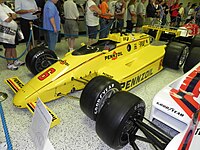1984 Indianapolis 500
 |
|||||
| Indianapolis Motor Speedway | |||||
|---|---|---|---|---|---|
| Indianapolis 500 | |||||
| Sanctioning body | USAC | ||||
| Season |
1984 CART season 1983-84 Gold Crown |
||||
| Date | May 27, 1984 | ||||
| Winner | Rick Mears | ||||
| Winning team | Penske Racing | ||||
| Average speed | 163.612 mph (263.308 km/h) | ||||
| Pole position | Tom Sneva | ||||
| Pole speed | 210.029 mph (338.009 km/h) | ||||
| Fastest qualifier | Sneva | ||||
| Rookie of the Year | (co) Roberto Guerrero & Michael Andretti | ||||
| Most laps led | Mears (119) | ||||
| Pre-race ceremonies | |||||
| National anthem | Purdue Band | ||||
| "Back Home Again in Indiana" | Jim Nabors | ||||
| Starting Command | Mary F. Hulman | ||||
| Pace car | Pontiac Fiero | ||||
| Pace car driver | John Callies (Pontiac) | ||||
| Honorary starter | none | ||||
| Attendance | 250,000 (estimated) | ||||
| TV in the United States | |||||
| Network | ABC | ||||
| Announcers | Jim McKay, Sam Posey | ||||
| Nielsen Ratings | 12.9 / 25 | ||||
| Chronology | |||||
|
|||||
The 68th Indianapolis 500 was held at the Indianapolis Motor Speedway in Speedway, Indiana on Sunday May 27, 1984. Rick Mears, who previously won in 1979, won his second Indy 500 driving for Penske. Contenders Tom Sneva and Mario Andretti dropped out of the race in the second half, leaving Mears alone two laps ahead of the field, and he cruised to the victory. Three months after the race, however, Mears would suffer severe leg injuries in a practice crash at Sanair.
Three rookies finished in the top five: Roberto Guerrero (2nd), Al Holbert (4th), and Michael Andretti (5th). Guerrero and Andretti shared the rookie of the year award. The race is well-remembered for the terrible crash of sportswriter-turned-racer, Pat Bedard, who tumbled through the infield in turn 4 on lap 58. Another rookie, two-time World Champion and future two-time Indy winner Emerson Fittipaldi made a quiet debut.
The race was sanctioned by USAC, and was included as part of the 1984 CART PPG Indy Car World Series. The 1984 race has the distinction of having the record for most entries (117), and the most cars to actually be seen in the garage (87). Defending race winner Tom Sneva, who broke the 200 mph barrier during time trials in 1977, headlined qualifying on pole day. Sneva made history once again, as he became the first driver to break the 210 mph barrier, en route to his third pole position.
...
Wikipedia
